Metal-Plated Connections in Sustainable Lightweight Construction: A Weak Link in Fire Conditions?
Abstract
1. Introduction
2. Materials and Methods
2.1. Lightweight Wood–Gusset Plate Specimens Subjected to Radiant Heat Fluxes
- Bare: no coating was applied to the surface of the plate or wood.
- Bare and toothless: no coating was applied to the surface and all teeth were removed except four corner teeth necessary to affix the plate to the wood.
- Soot-coated: candle flame soot was applied to cover the surface of the plate and wood.
- Soot-coated and toothless: candle flame soot was applied to the surface and all teeth were removed except four corner teeth necessary to affix the plate to the wood.
2.2. Instrumentation and Test Matrix
- ▪
- Between the plate and wood (TC1)
- ▪
- Directly beneath a row of teeth of the gusset plate (TC2)
- ▪
- Between the two rows of teeth of the gusset plate (TC3)
- ▪
- Beneath the exposed wood (TC4)
3. Results and Discussion
- Below 200 °C: endothermic dehydration.
- 200–500 °C: exothermic reaction of hemicellulose and lignin with two peaks around 275 and 365 °C, respectively.
- 300–400 °C: endothermic reaction of cellulose with a strong peak of around 360 °C.
- Above 500 °C: exothermic reaction of cellulose and endothermic reaction of hemicellulose and lignin.
3.1. Effect of Surface Absorptivity (Soot-Coated vs. Bare)
3.2. Effect of Teeth
3.3. Visual Damage Assessment
3.4. Connection Strength Assessment
3.5. Limitations
4. Conclusions
- A bare gusset plate provides some protection for the wood beneath at a 20 kW/m2 external radiant heat.
- Soot-coating on the bare gusset plate increases radiation absorption and does not protect the wood beneath at 20 kW/m2 with significant charring occurring.
- The presence of teeth has a minor effect on the internal wood temperature for the bare gusset plates for an external radiant heat exposure up to 20 kW/m2 but is more significant for soot-covered specimens.
- Connection strength is quickly lost in the soot-covered specimens when compared to the bare specimens.
Author Contributions
Funding
Institutional Review Board Statement
Informed Consent Statement
Data Availability Statement
Acknowledgements
Conflicts of Interest
References
- Preventing Injuries and Deaths of Fire Fighters Due to Truss System Failures; U.S. Department of Health and Human Services, Public Health Service, Centers for Disease Control and Prevention, National Institute for Occupational Safety and Health: Cincinnati, OH, USA, 2005.
- Stroup, D.W.; Bryner, N.P.; Lee, J.; McElroy, J.; Roadarmel, G.; Twilley, W.H. Structural Collapse Fire Tests: Single Story, Wood Frame Structures; Fire Research Division, Building and Fire Research Laboratory, National Institute of Standards and Technology: Caithersburg, MD, USA, 2004. [Google Scholar]
- Roof Collapse Injures Four Career Fire Fighters at a Church Fire—Arkansas. U.S. Department of Health and Human Services, Public Health Service, Centers for Disease Control and Prevention, National Institute for Occupational Safety and Health: Cincinnati, OH, USA, 2001.
- Brassell, L.D.; Evans, D.D. Trends in Firefighter Fatalities Due to Structural Collapse, 1979–2002; National Institute of Standards and Technology: Gaithersburg, MD, USA, 2003; p. NIST IR 7069. [Google Scholar]
- Firefighter Fatalities in the United States. Available online: https://www.usfa.fema.gov/statistics/reports/firefighters-departments/firefighter-fatalities.html (accessed on 5 November 2023).
- Kerber, S. Analysis of Changing Residential Fire Dynamics and Its Implications on Firefighter Operational Timeframes. Fire Technol. 2012, 48, 865–891. [Google Scholar] [CrossRef]
- NFPA 1710; Standard for the Organization and Deployment of Fire Suppression Operations, Emergency Medical Operations, and Special Operations to the Public by Career Fire Departments. NFPA: Quincy, MA, USA, 2020. Available online: https://www.nfpa.org/codes-and-standards/nfpa-1710-standard-development/1710 (accessed on 23 October 2023).
- NFPA 1720; Standard for the Organization and Deployment of Fire Suppression Operations, Emergency Medical Operations, and Special Operations to the Public by Volunteer Fire Departments. NFPA: Quincy, MA, USA, 2020. Available online: https://www.nfpa.org/codes-and-standards/nfpa-1720-standard-development/1720 (accessed on 23 October 2023).
- Topical Fire Research Series: Structure Fire Response Times; US Fire Administration/National Fire Data Center: Emmitsburg, MD, USA, 2006.
- Ling, T.; Mohrmann, S.; Li, H.; Bao, N.; Gaff, M.; Lorenzo, R. Review on Research Progress of Metal-Plate-Connected Wood Joints. J. Build. Eng. 2022, 59, 105056. [Google Scholar] [CrossRef]
- Grundahl, K. Fire Performance of Trusses Reference Guide. Available online: https://sbcindustry.com/sites/default/files/uploads/attachments/node/128/fireperf_kg.pdf (accessed on 29 September 2023).
- Percival, D.H.; Suddarth, S.K. An Investigation of the Mechanical Characteristics of Truss Plates on Fire-Retardant Treated Wood. 1971. Available online: https://www.ideals.illinois.edu/items/54981 (accessed on 23 October 2023).
- White, R.; Cramer, S. Improving the Fire Endurance of Wood Truss Systems. In Proceedings of the Timber Shaping the Future, Gold Coast, Australia, 11–15 July 1994; Available online: https://www.fpl.fs.usda.gov/documnts/pdf1994/white94a.pdf (accessed on 23 October 2023).
- Jordan, J.W.; Sokol, M.A.; Stewart, J.H. Fire Damage Evaluation for Residential and Commercial Buildings. Available online: https://ascelibrary.org/doi/epdf/10.1061/9780784412640.057 (accessed on 21 October 2023).
- Mike, J. (Ed.) SFPE Handbook of Fire Protection Engineering, 3rd ed.National Fire Protection Association, Society of Fire Protection Engineers: Quincy, MA, USA; Bethesda, MD, USA, 2002; ISBN 978-0-87765-451-3. [Google Scholar]
- Malanga, R. Fire Endurance of Lightweight Wood Trusses in Building Construction. Fire Technol. 1995, 31, 44–61. [Google Scholar] [CrossRef]
- Brandon, D.; Maluk, C.; Ansell, M.P.; Harris, R.; Walker, P.; Bisby, L.; Bregulla, J. Fire Performance of Metal-Free Timber Connections. Proc. Inst. Civ. Eng.-Constr. Mater. 2015, 168, 173–186. [Google Scholar] [CrossRef]
- Barber, D.; Gerard, R. Summary of the Fire Protection Foundation Report—Fire Safety Challenges of Tall Wood Buildings. Fire Sci. Rev. 2015, 4, 5. [Google Scholar] [CrossRef]
- Sultan, M.A. Fire Resistance of Wood Truss Floor Assemblies. Fire Technol. 2015, 51, 1371–1399. [Google Scholar] [CrossRef]
- Harman, K.A.; Lawson, J.R. A Study of Metal Truss Plate Connectors When Exposed to Fire; National Institute of Standards and Technology: Gaithersburg, MD, USA, 2007; p. NIST IR 7393. [Google Scholar]
- White, R.H. Fire Endurance Model for a Metal-Plate-Connected Wood Truss; U.S. Department of Agriculture, Forest Service, Forest Products Laboratory: Washington, DC, USA, 1993. [Google Scholar]
- Ancona, S. How They Fail: Gusset Plates—Building Construction for Firefighters 2022. Available online: https://www.fireengineering.com/fire-prevention-protection/building-construction-how-they-fail-gusset-plates/ (accessed on 23 October 2023).
- Subyakto; Hata, T.; Ide, I.; Yamane, T.; Kawai, S. Fire Protection of a Laminated Veneer Lumber Joint by Wood Carbon Phenolic Spheres Sheeting. J. Wood Sci. 2004, 50, 157–161. [Google Scholar] [CrossRef]
- Subyakto, B.; Hata, T.; Ide, I.; Kawai, S. Fire-Resistant Performance of a Laminated Veneer Lumber Joint with Metal Plate Connectors Protected with Graphite Phenolic Sphere Sheeting. J. Wood Sci. 2001, 47, 199–207. [Google Scholar] [CrossRef]
- McKendry, P. Energy Production from Biomass (Part 1): Overview of Biomass. Bioresour. Technol. 2002, 83, 37–46. [Google Scholar] [CrossRef] [PubMed]
- Borovkova, V.S.; Malyar, Y.N.; Sudakova, I.G.; Chudina, A.I.; Skripnikov, A.M.; Fetisova, O.Y.; Kazachenko, A.S.; Miroshnikova, A.V.; Zimonin, D.V.; Ionin, V.A.; et al. Molecular Characteristics and Antioxidant Activity of Spruce (Picea Abies) Hemicelluloses Isolated by Catalytic Oxidative Delignification. Molecules 2022, 27, 266. [Google Scholar] [CrossRef] [PubMed]
- Yang, H.; Yan, R.; Chen, H.; Lee, D.H.; Zheng, C. Characteristics of Hemicellulose, Cellulose and Lignin Pyrolysis. Fuel 2007, 86, 1781–1788. [Google Scholar] [CrossRef]
- Bennaji, N.; Mellouki, I.; Yacoubi, N. Thermal Properties of Metals Alloy by Electrical Pyroelectric Method (EPE). J. Phys. Conf. Ser. 2010, 214, 012138. [Google Scholar] [CrossRef]
- Božiková, M.; Kotoulek, P.; Bilčík, M.; Kubík, Ľ.; Hlaváčová, Z.; Hlaváč, P. Thermal Properties of Wood and Wood Composites Made from Wood Waste. Int. Agrophys. 2021, 35, 251–256. [Google Scholar] [CrossRef] [PubMed]
- Bilotta, A.; de Silva, D.; Nigro, E. Tests on Intumescent Paints for Fire Protection of Existing Steel Structures. Constr. Build. Mater. 2016, 121, 410–422. [Google Scholar] [CrossRef]

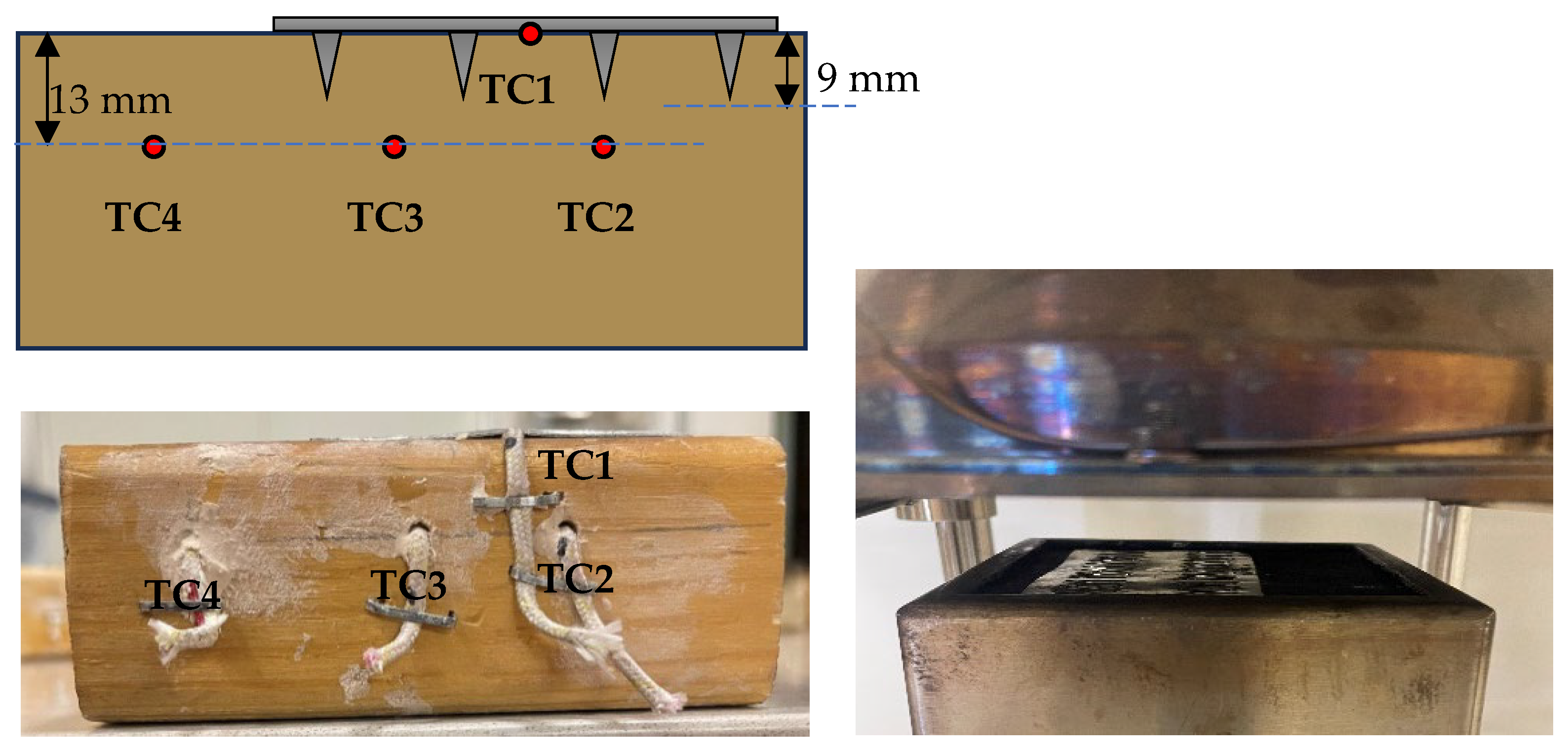

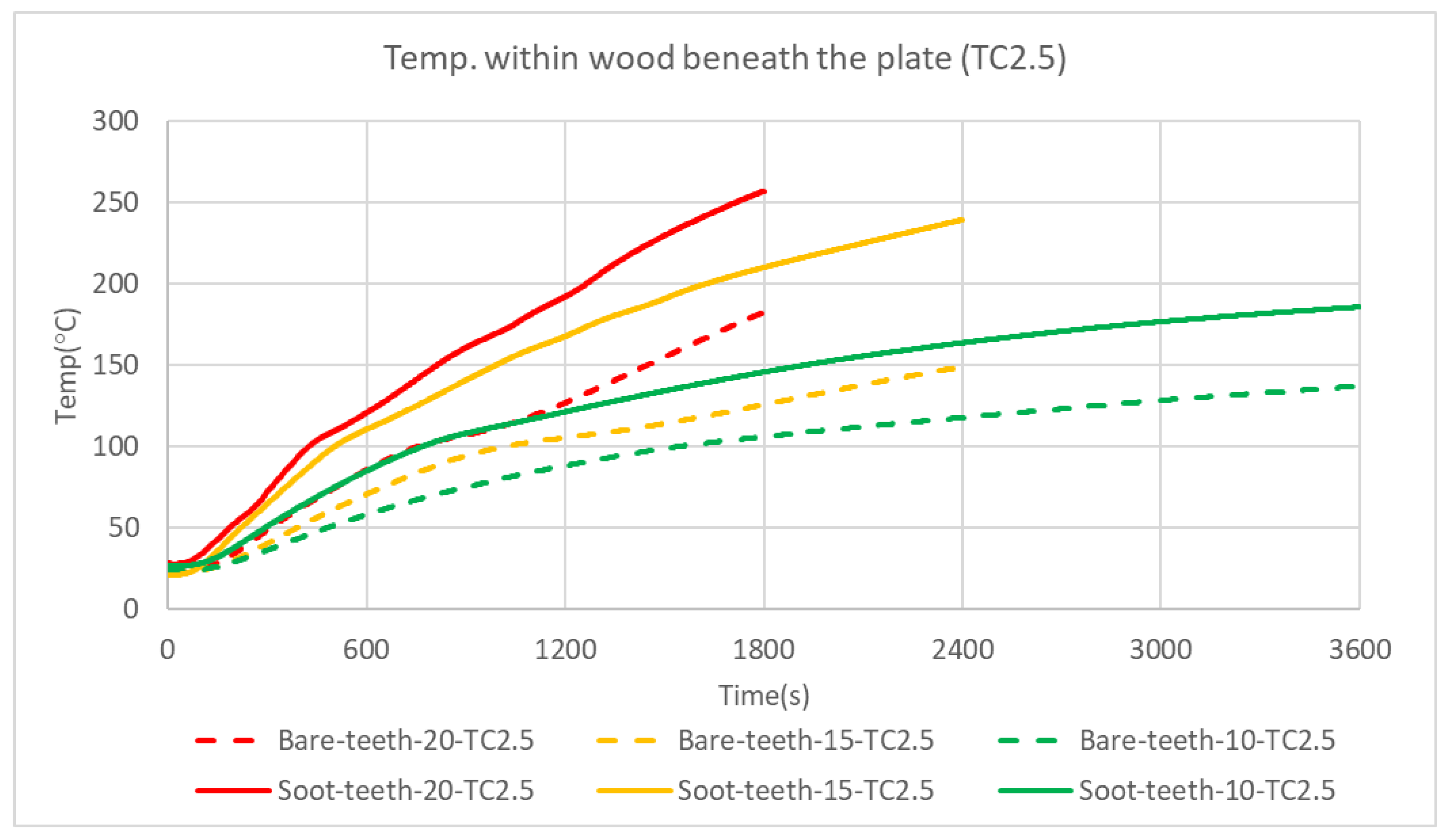
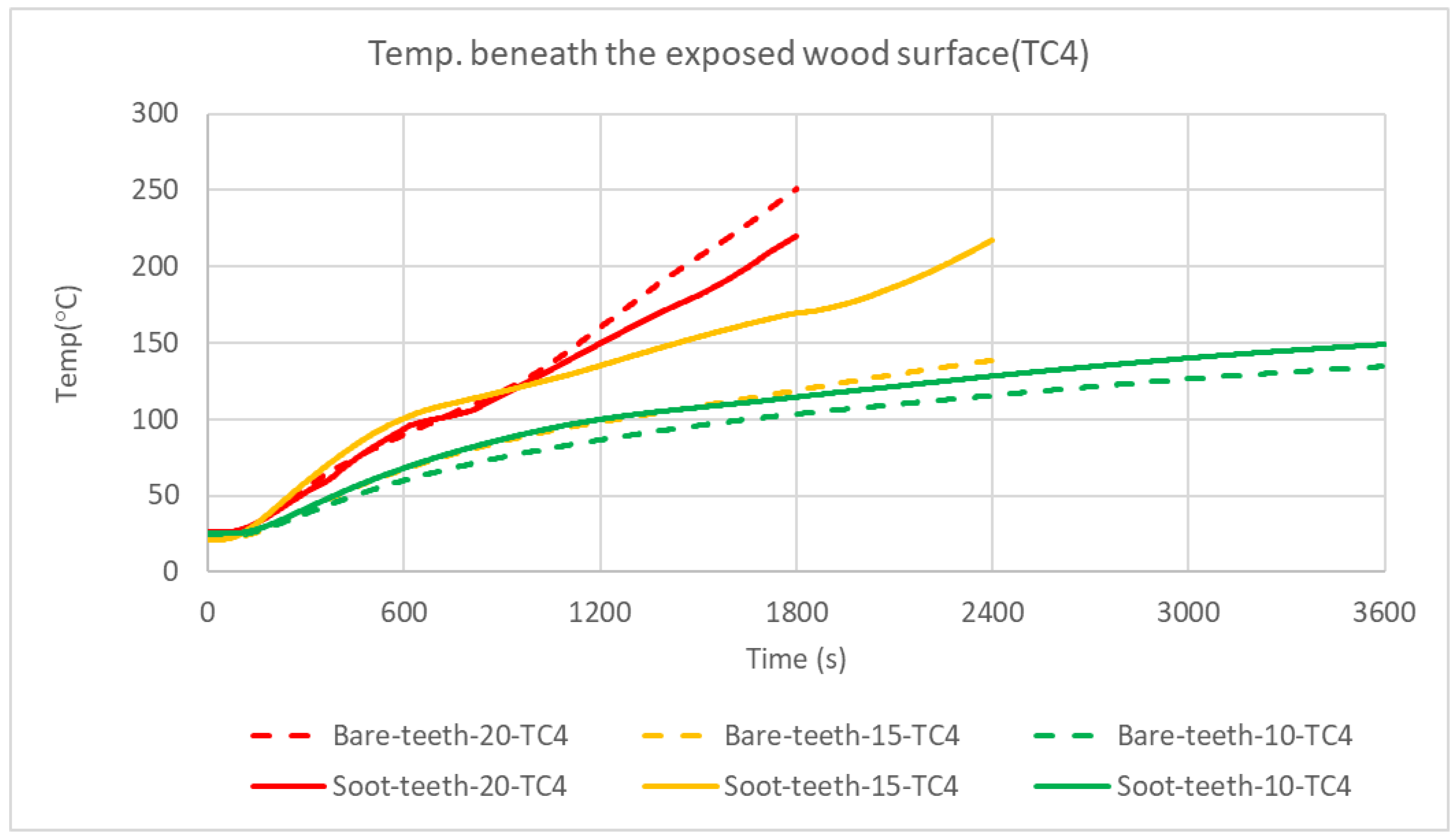

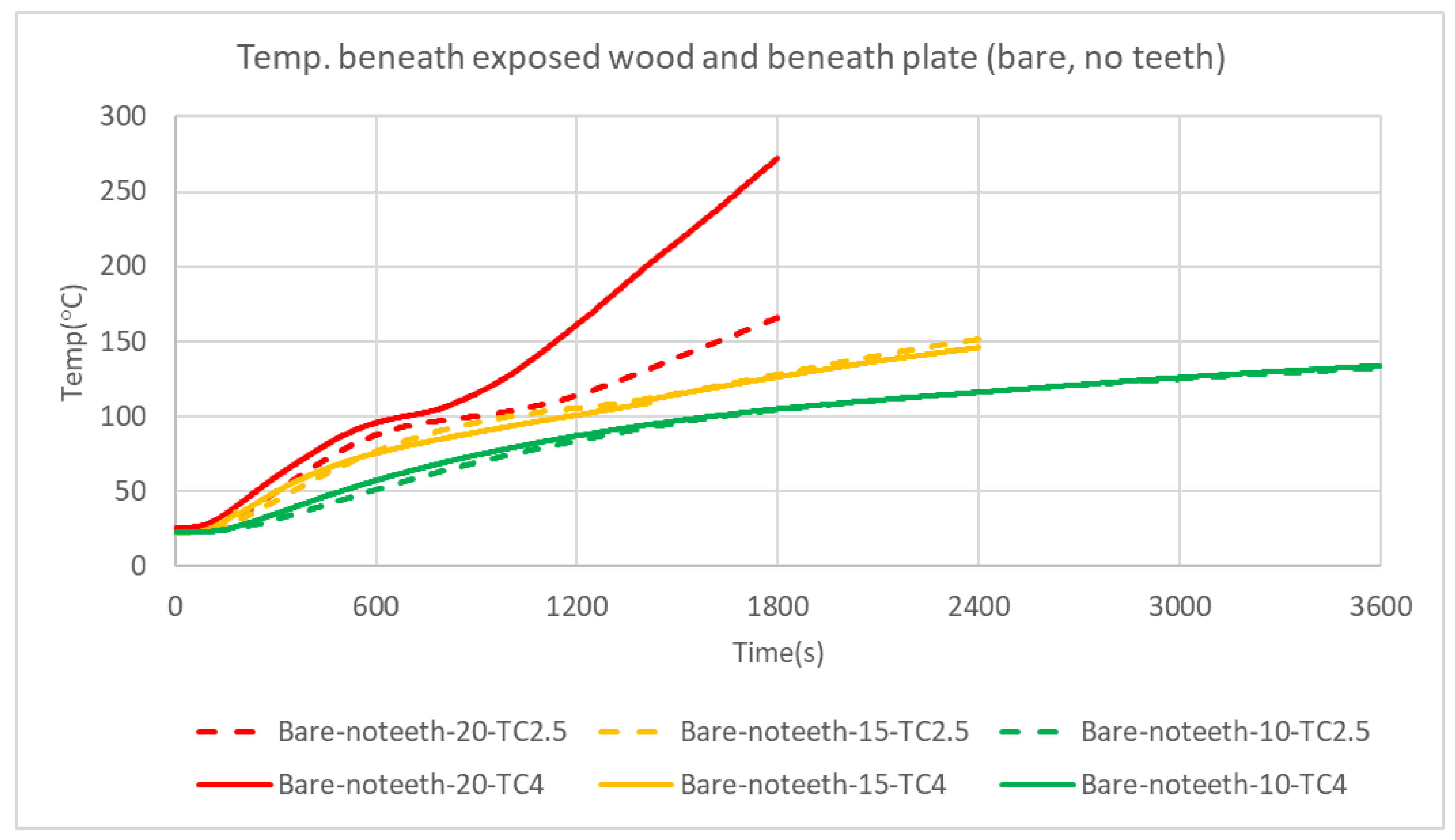
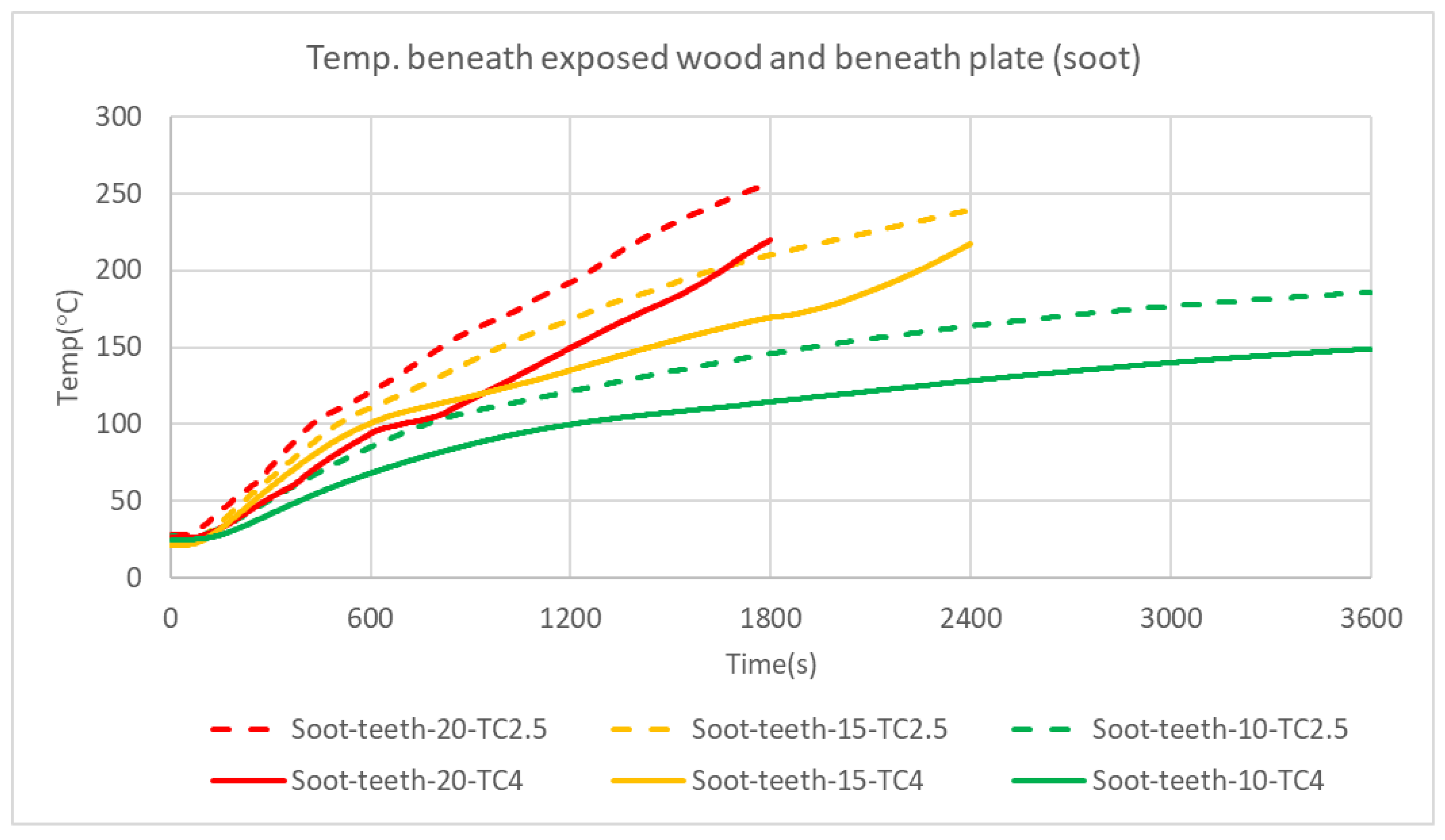
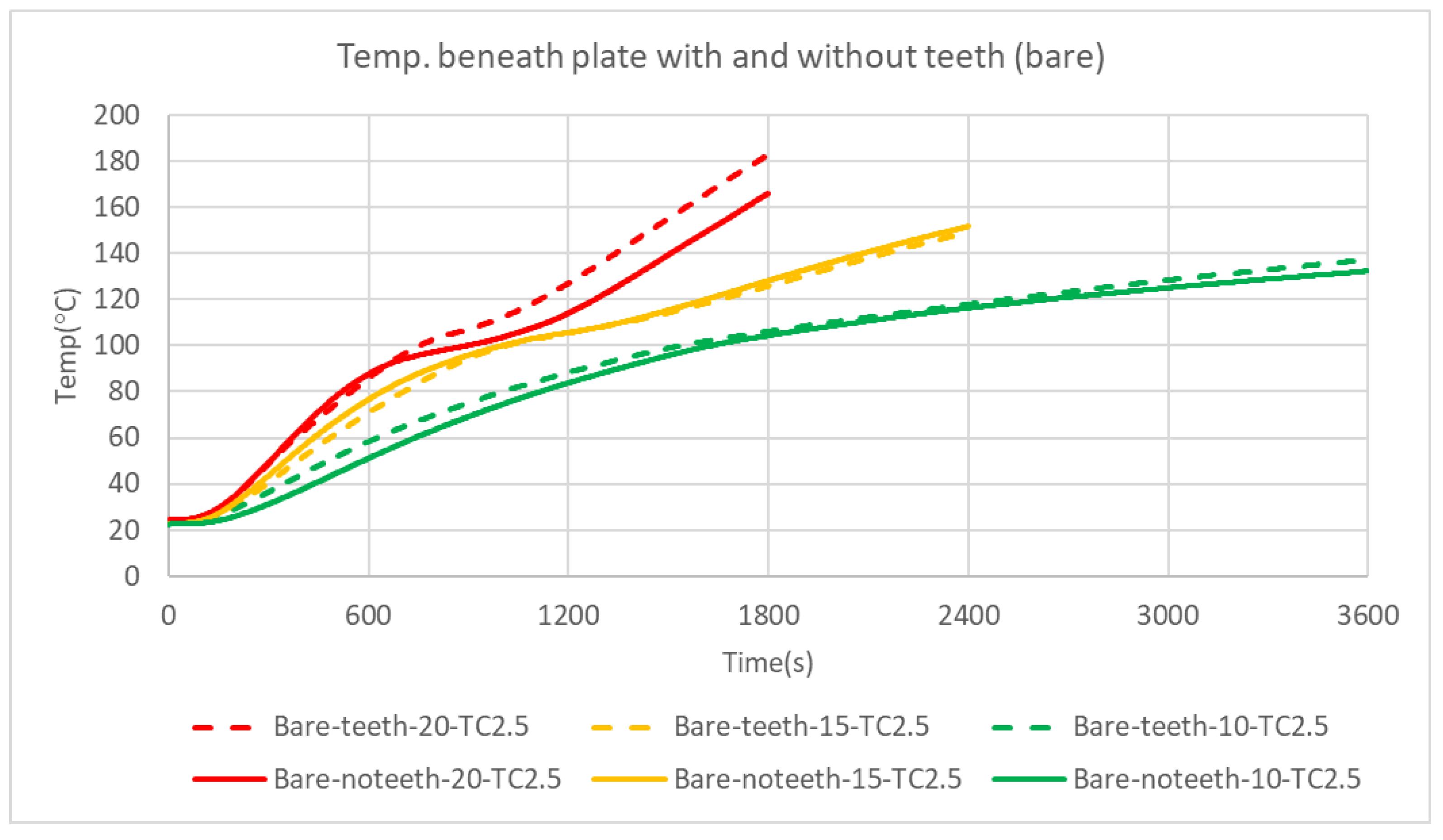
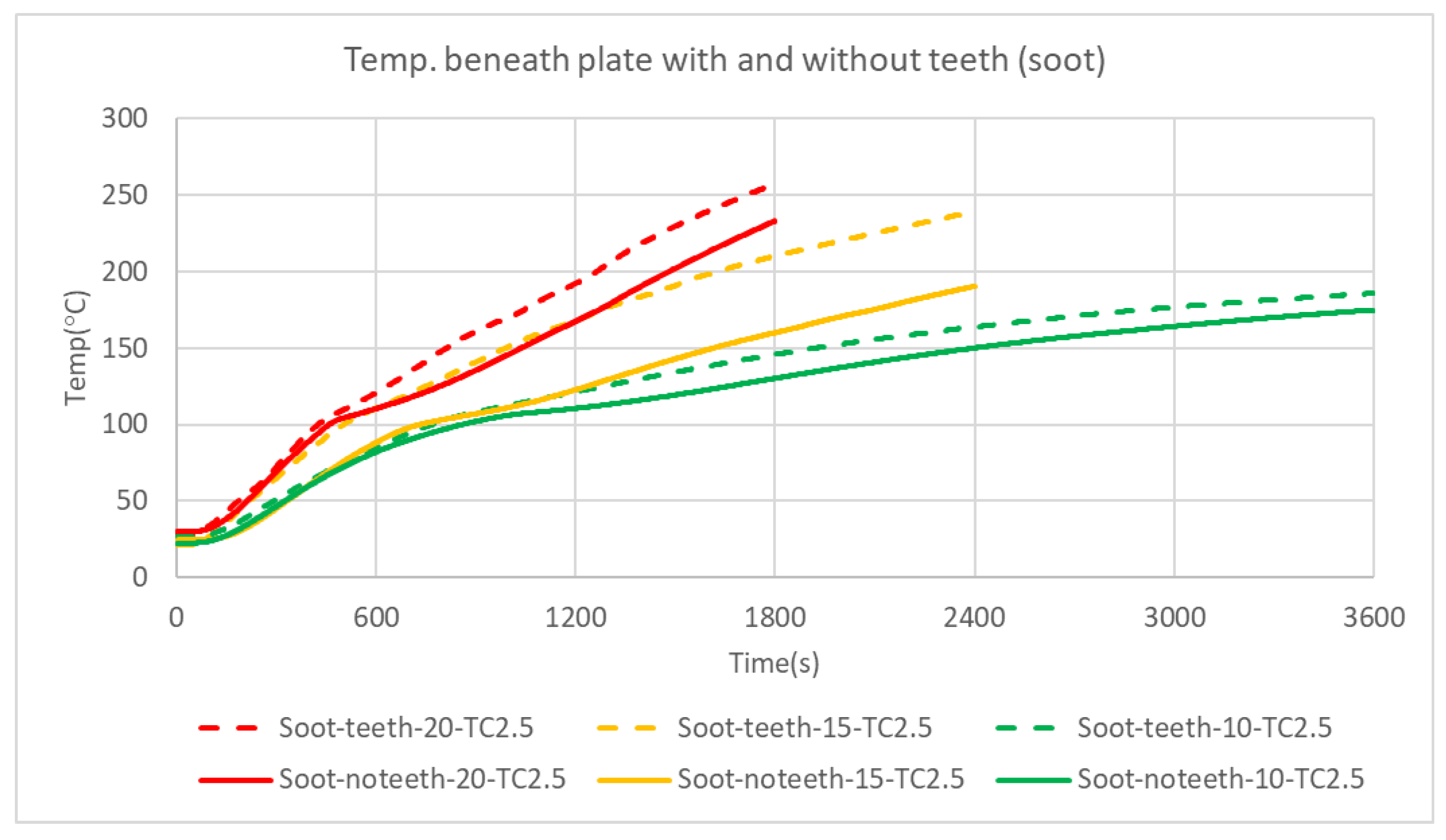
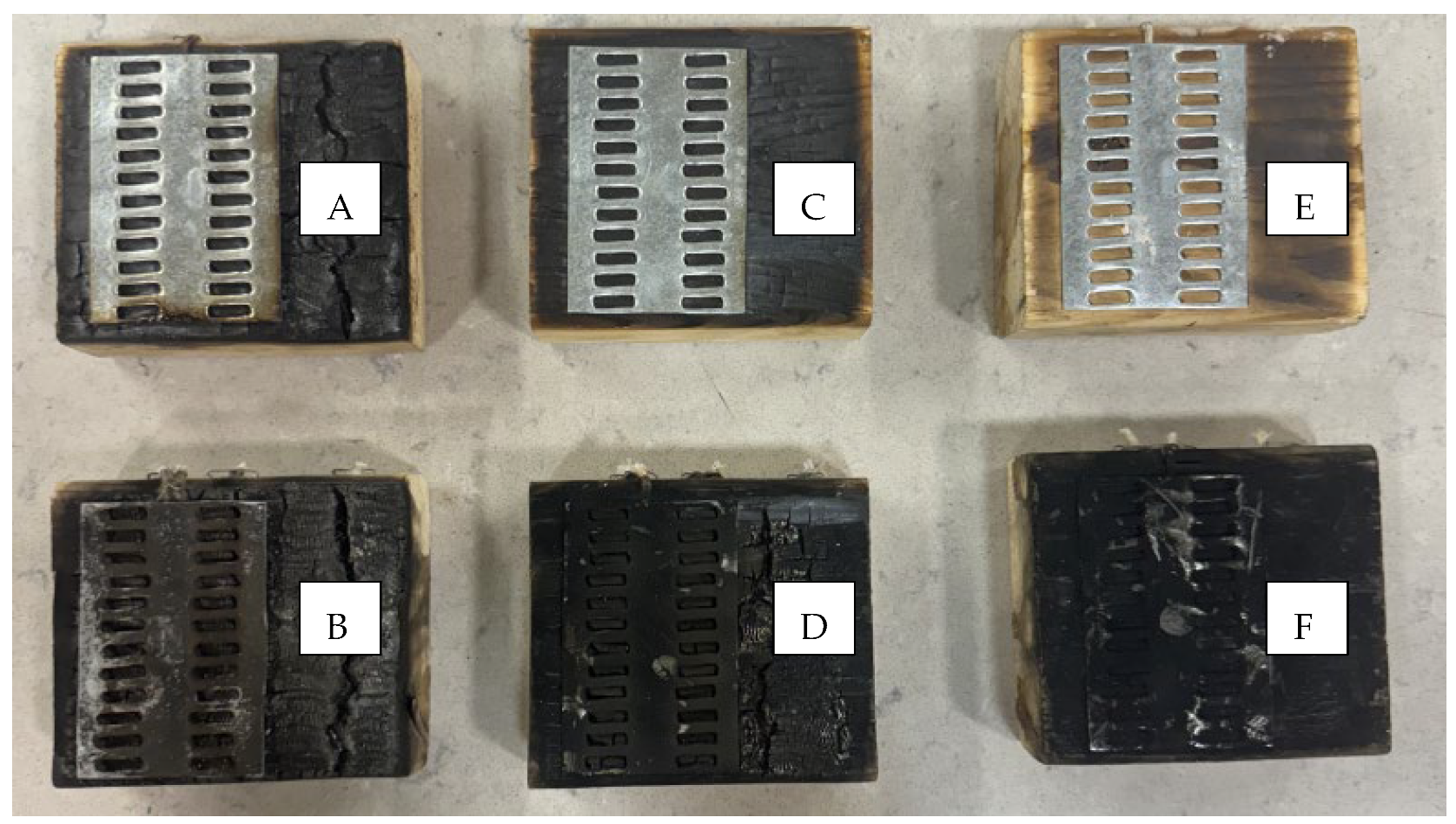

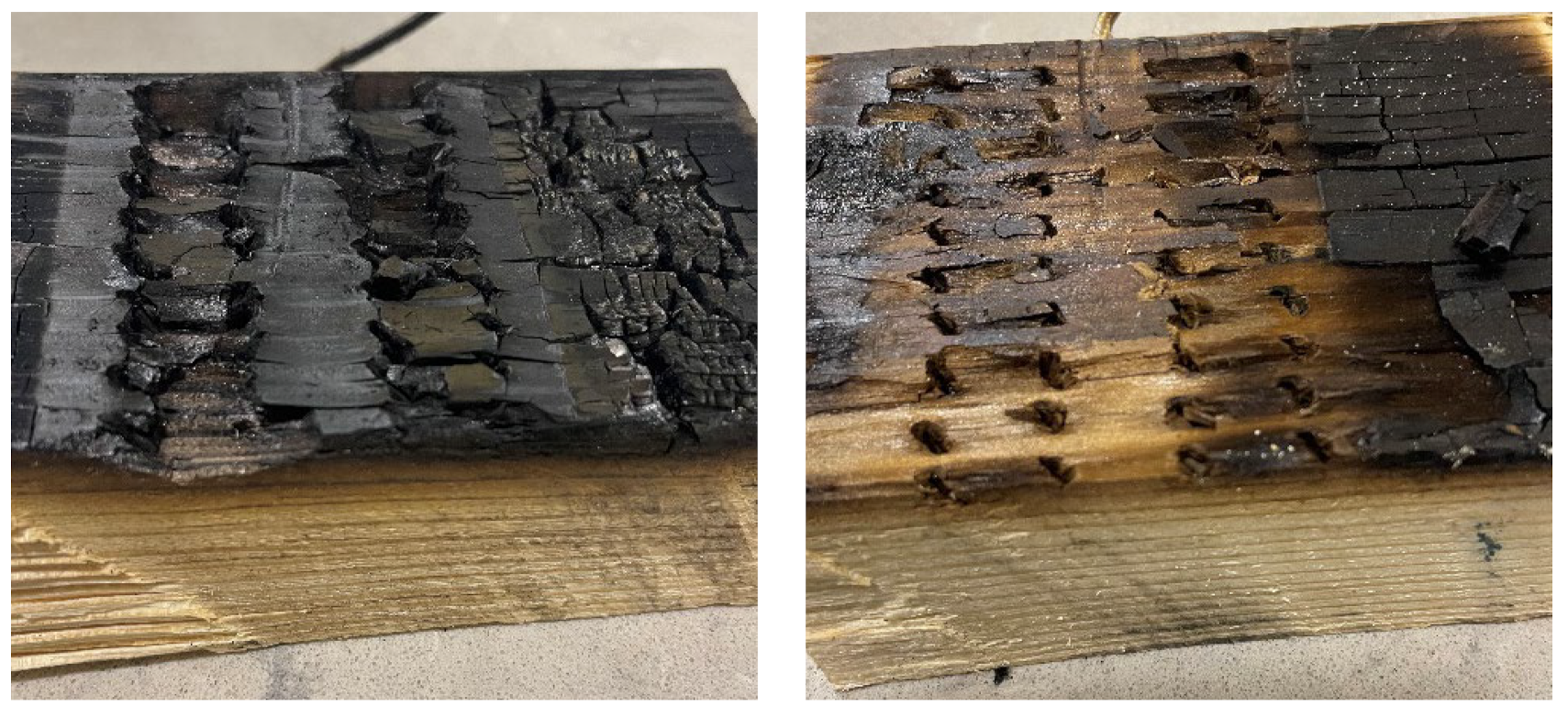
| Test Number | Test Name | Surface | Teeth Presence | External Heat Flux (kW/m2) |
|---|---|---|---|---|
| 1 | Bare-teeth-10 | Bare | Teeth | 10 |
| 2 | Bare-teeth-15 | Bare | Teeth | 15 |
| 3 | Bare-teeth-20 | Bare | Teeth | 20 |
| 4 | Soot-teeth-10 | Soot | Teeth | 10 |
| 5 | Soot-teeth-15 | Soot | Teeth | 15 |
| 6 | Soot-teeth-20 | Soot | Teeth | 20 |
| 7 | Bare-noteeth-10 | Bare | No teeth | 10 |
| 8 | Bare-noteeth-15 | Bare | No teeth | 15 |
| 9 | Bare-noteeth-20 | Bare | No teeth | 20 |
| 10 | Soot-noteeth-10 | Soot | No teeth | 10 |
| 11 | Soot-noteeth-15 | Soot | No teeth | 15 |
| 12 | Soot-noteeth-20 | Soot | No teeth | 20 |
Disclaimer/Publisher’s Note: The statements, opinions and data contained in all publications are solely those of the individual author(s) and contributor(s) and not of MDPI and/or the editor(s). MDPI and/or the editor(s) disclaim responsibility for any injury to people or property resulting from any ideas, methods, instructions or products referred to in the content. |
© 2024 by the authors. Licensee MDPI, Basel, Switzerland. This article is an open access article distributed under the terms and conditions of the Creative Commons Attribution (CC BY) license (https://creativecommons.org/licenses/by/4.0/).
Share and Cite
Kubicki, M.; Park, H. Metal-Plated Connections in Sustainable Lightweight Construction: A Weak Link in Fire Conditions? Sustainability 2024, 16, 6923. https://doi.org/10.3390/su16166923
Kubicki M, Park H. Metal-Plated Connections in Sustainable Lightweight Construction: A Weak Link in Fire Conditions? Sustainability. 2024; 16(16):6923. https://doi.org/10.3390/su16166923
Chicago/Turabian StyleKubicki, Michael, and Haejun Park. 2024. "Metal-Plated Connections in Sustainable Lightweight Construction: A Weak Link in Fire Conditions?" Sustainability 16, no. 16: 6923. https://doi.org/10.3390/su16166923
APA StyleKubicki, M., & Park, H. (2024). Metal-Plated Connections in Sustainable Lightweight Construction: A Weak Link in Fire Conditions? Sustainability, 16(16), 6923. https://doi.org/10.3390/su16166923







